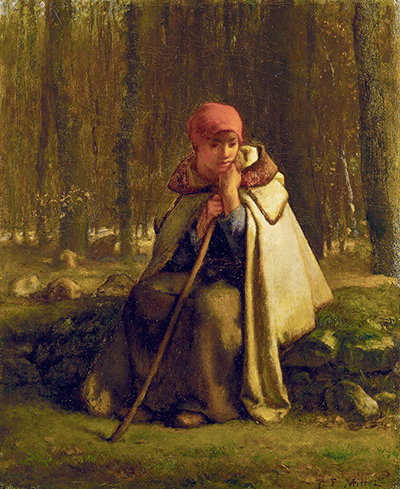The painting, Seated Shepherdess, is an oil on board painting done by Jean Millet dating from the late 1840s. The paint depicts a young shepherdess seated in peaceful contemplation, her mind far away from her grazing flock. Her twisting pose almost looks like a classical sculpture but has been made realistic by her clothes, tanned skin color, and a big work wone hands.
Jean Millets work changed from the role of rural peasant workers, mostly depicting struggles that they go through, to focussing on the rigors labor, often appearing as independent and iconic.
Calm, tranquility, and harmony form the main atmosphere of this painting, Seated Shepherdess. The main subject wears a scarf on her head, a red half coat and long-sleeved blouse with a white and black dress, the young shepherdess, probably the painter`s daughter, is seated leaning aginst a tree.
In a monotonous field covering, a huge forest in the background, she is alone with the sheep. The scene is a lovely mix of accuracy and melancholy. The printer makes use of jungle green, dark green, and deep brownish color.The lighting of the paint, Seated Shepherdess, is from a natural source the sun and it reflects the daunting figures of the grazing sheep. The general mood of the painting is thought provoking for its admirer, and peaceful and relaxing for the subject in the paint.
The paint stands out as a masterpiece, exquisite or the most peaceful of scenery captivating and attracting all those who prefer paintings of the country side to those of struggling squalors. The painting may have been inspired by the Forest of Fontainebleu in Barbizon, Millets home from 1849. It was in the distinguished collection of Henri Rouart, then purchased by Margaret Davies in 1912 then given away after her death in 1963.
Jean Millet was greatly influenced by the painter paul Dumouchel, whom Millet studied under. He was also taught on a full-time basis by Lucien Theophile Langlois. Millet's artwork had an almost religious touch which made them easily acceptable. He also had a great influence on young artists like Eugen Boudin, Claude Monet, and Pablo Picasso.
Other famous landscape artworks by Millet include Harvester Resting of 1850, Walk to Work of 1851, Woman Baking Bread of 1854, The Gleaners of 1857. The Man with a Hoe of 1869 and The Potato Planters of 1861 among many others.
Jump to top




